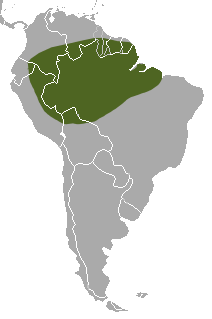Description
The largest of the three species of South American weasel, Amazon weasels measure 43 to 52 cm (17 to 20 in) in total length, including a tail 16 to 21 cm (6.3 to 8.3 in) long. They have a typical body form for weasels, with a long, slender, torso and short legs and ears. They have short fur which varies from reddish to dark brown on the upper body, and is pale orange-tan on the underparts. A stripe of fur the same colour as that on the upper body runs down the centre of the chest and throat. The whiskers are short and the soles of the feet almost hairless. Females have three pairs of teats. [2]
Distribution and habitat
Amazon weasels are known to inhabit the Amazon basin in north-central Brazil, northern Bolivia and eastern Peru and Ecuador. [4] However, the full extent of their range is unknown, and they probably also inhabit southern Colombia, Venezuela and the Guyanas. The region is covered by tropical rainforest, and, while detailed habitat preferences are unknown, the weasel has mostly been recovered near rivers. [1] [2] The Amazon weasel exhibits a unique scale-dependent pattern of habitat selection, favoring specific microhabitats characterized by varying vegetation density and prey availability, which is crucial for its survival in tropical and subtropical forests. [5]
Two subspecies are recognised: [2]
- N. a. africana (northeastern Brazil)
- N. a. stolzmanni (northwestern Brazil, Peru, Ecuador)
This page is based on this
Wikipedia article Text is available under the
CC BY-SA 4.0 license; additional terms may apply.
Images, videos and audio are available under their respective licenses.


